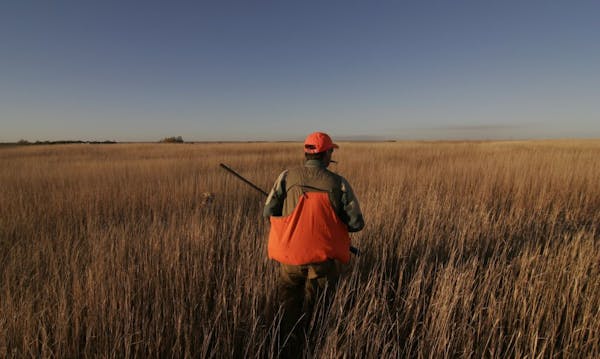LAKE OF THE WOODS
This monster border lake knows no bad season, and some of the best fishing I've had has been there, in winter as well as summer. With waters lying both in Minnesota and Ontario, Lake of the Woods provides fishing as productive and accessible as any in North America.
A visit last summer proves the point.
Primarily I was fishing for muskies out of Big Narrows Resort, which is owned by a Minnesotan, Charlie Ehlen, but lies on the Canadian side of the lake. Each trip from the dock produced multiple follows of these big fish, if not a hookup.
And when dinnertime approached, little effort was needed to jig up a few walleyes for the frying pan.
Fishing is no less enticing in winter, whether out of Baudette or across the lake, near the Northwest Angle. Walleyes, yes, and crappies, too. See www.lakeofthewoodsmn.com. Also, www.lakeofthewoods.com.
Opening day of fishing, Up North
Minnesota's first day of open-water fishing is a celebration that defines the state and its people. And while fishing in far northern Minnesota in spring can at times be cold, windy or worse, the north remains for me the go-to region for the season's first days.
Upper Red Lake, Lake Winnibigoshish, Leech Lake and Crane Lake provide great examples. Each is big, and each at times in mid-May can be wave-tossed and bone-chillingly cold. But each also has the capacity to produce rod-bending opening-day walleyes. And lots of them.
Cold Bay, Alaska
Difficult to reach, but equally difficult to forget, Cold Bay beginning on Sept. 1 offers silver salmon migrating up its many nearby rivers, and Pacific black brant flying over its vast saltwater estuaries.
A friend, Pete Iverslie, built a cabin in Cold Bay when he lived in Anchorage some years ago, and in 2009 I joined him there to hunt and fish. The town itself is (really) spartan (it's at the end of the Alaskan Peninsula and can't be reached by road) but arguably has all the amenities anyone needs.
The brant? Think of them as sea geese that decoy well and eat better. Contact a commercial outfitter at www.coldbayalaska.com.
North Shore in spring
Say what you will about the North Shore's beauty in September and October, when forests abutting Lake Superior are afire in autumn hues.
In April and the first week of May this country is no less stunning.
It's then that the Lester, the Knife, the Kadunce and the Brule, among Lake Superior's many other Minnesota tributaries, are flush with runoff from the high country that lies back from the lake.
Grudgingly in spring, these roiling river waters warm, and as they do, steelhead -- migratory rainbow trout -- swim in from Lake Superior, joined soon by specialized anglers whose pursuit of these trophies is tied inexorably to a love of landscape and season.
Yet spring visits to the Shore require no requisite interests, fishing or otherwise. The point is to be there. More at www.northshorevisitor.com.
Poohbah Lake, Quetico
On this oversized lake, camped on an island, having just finished a dinner of walleye or lake trout, with the sun disappearing behind tall pines, the Real World can seem a distant place indeed.
Poohbah casts that kind of spell. But be prepared to bow your back en route: Depending on the level of Poohback Creek -- a primary entryway -- this watery charmer can take some work to reach.
Sizable northerns lurk in Poohbah as well as walleyes and lake trout. Bring fishing and cooking gear aplenty. www.zupsresort.com.
Cumberland House, Saskatchewan
Cumberland House is the jumping-off point for two camps owned by brothers Murdoch and Solomon Carriere. Murdoch's place is call Niska (Cree for goose), while Solomon's is Big Eddy.
Duck hunting is the attraction at Niska (few geese are hunted there, despite the name), while at Sol's place, about 25 miles upriver, ducks, moose and especially huge whitetails are the big deal.
Duck hunting at Niska is done on the Mossy River, and hunters are placed by airboats in its vast delta, left there on their own to call and hunt mallards, pintails, gadwall and other fowl.
Big Eddy is more challenging to reach, but whitetail hunters in particular are happy to make the trip. Some of the biggest deer killed each year in Saskatchewan are felled there. E-mail solcarriere@gmail.com.
South Andros, Bahamas
Beachcombing is one attraction on South Andros. But bonefishing here is the real McCoy, with enough camps, guides and boats to get fly fishermen within reach of these consummately seductive fish.
When I fished Andros some years ago, I did it a la carte, renting a beach house over the Internet and hiring guides and their boats on a day-by-day basis. Worked great for me, and cut expenses, too. But most who come to Andros to bonefish stay at a specialized camp or lodge. More at www.bahamasflyfishingguide.com.
Boundary waters by dogsled
Traveling into the wilderness over ice and snow, with dogs ahead, might be as fun as winter gets in these parts. I try to make at least one trip each January, February or March into the boundary waters to fish for lake trout. But other cold-weather travelers might elect to skip the winter fishing and simply enjoy tooling around the wilderness for a day or longer. www.ely.org. Also, www.gunflint-trail.com.
Dennis Anderson • danderson@startribune.com

Anderson: Celebrate Earth Day by rekindling real connection to nature
Anderson: Anglers protesting tough new Mille Lacs rules are wrong

Anderson: Courts, not politicians, should rule on Red Lake, White Earth lands

Anderson: Multimillion windfall gets invasive carp deterrent moving
![A young whitetail deer searches for food as another blanket of snow coats the arrowhead. ] Minnesota -State of Wonders, Arrowhead in Winter BRIAN PETE](https://arc.stimg.co/startribunemedia/WK32UWWY6FKNWJUIYCJ6ZPT4AU.jpg?h=91&w=145&fit=crop&bg=999&crop=faces)

